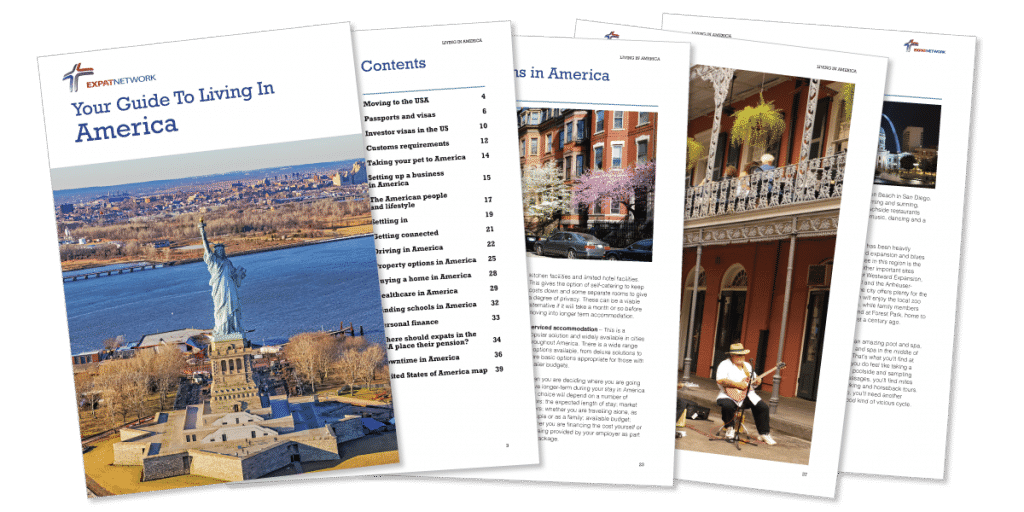
Your Guide to Living and Working in The USA
Moving to Live, Work, Or Retire In America
As the largest economy in the world it is inevitable that many people will either find themselves asked to
spend time working in America as part of their career or will be drawn by the American Dream and lifestyle to take up temporary or permanent residence in the US.
America is the third largest country in the world with a population of 337 million. The country has
developed from its native American roots following a series of waves of immigration and has drawn in
people from all over the world. As a result it is one of the most culturally diverse places in the world, often
described as a ‘melting pot’. In such a vast country it is virtually impossible to describe a ‘typical’ American.
Different regions of America have been influenced to various degrees by the different ethnicities and
cultures giving each a unique balance. They are drawn together by a belief in the ‘American Dream’, the
idea that with hard work and talent anyone can achieve great success and wealth. Success is praised and admired rather than envied, and this is one of the things that makes a major impression on newcomers from other countries.
Hard work is regarded as one of the core values of America and many employment contracts include much lower vacation time than would be offered by most European employers. New employees often get two weeks’ vacation initially and can then build additional weeks based on longevity with the company.
Immigration requirements
All visitors to the United States must hold a valid passport that expires six months or more after the date
you expect to leave the country.
If you are visiting America you may qualify for the visa waiver program, but if you are moving to America
there are a wide range of options for non-immigrant and immigrant visas depending on the reason for your move.
The U.S. Citizenship & Immigration Service (USCIS), under the Department of Homeland Security (DHS)
controls entry to the US. The US Department of Sate website has a Visa Wizard that allows you to work out what visa you are eligible for based on your citizenship, purpose of the travel.
The US has a Visa Waiver Program (VWP) which is available for visits of up to 90 days for holiday or
business purposes. In order to take advantage of this option you must be a citizen of one of the countries covered by this program. When entering using the VWP you must have a valid Electronic System for Travel Authorization (ESTA) approval prior to travel, which can be arranged online in a few minutes.
There are two main categories of visa available to people looking to spend time in the US: Immigrant and
Non-immigrant visas.
Non-immigrant visas
You can apply for a non-immigrant visa by downloading the appropriate form from the Department of State website. Before you travel to the United States for employment purposes, you must obtain USCIS approval.
You may also be required to file paperwork with the Department of Labor.
There are several subcategories of non-immigrant visas, depending upon the length of stay, multiple or
single entries, and other factors. Consulates can advise you on the appropriate visa, which often can be
processed and issued on the same day.
- Business visa (B-1) is applied for by the employer and must be approved by the Department of Homeland Security and the USCIS. Interviews are conducted by U.S. Embassies or Consulates abroad. It may take as long as 60 to 90 days for an open interview slot; the State Department website estimates the wait time, in each city, for an interview date.
- You can see a full list of Temporary Worker visas on the US Department of State website. The most common are as follows:
- H-1B: Person in Specialty Occupation – To work in a specialty occupation. Requires a higher education degree or its equivalent.
- L Intracompany Transferee Visa – To work at a branch, parent, affiliate, or subsidiary of the current employer in a managerial or executive capacity (or in a position requiring specialized knowledge). Individual must have been employed by the same employer abroad continuously for 1 year within the three preceding years.
- Individual with Extraordinary Ability or Achievement – For persons with extraordinary ability or achievement in business, the sciences, arts etc demonstrated by sustained national or international acclaim, to work in their field of expertise. Includes persons providing essential services in support of the above individual.
Some temporary worker visa categories require your prospective employer to obtain a labor certification or other approval from the Department of Labor before filing the Petition for a Non-immigrant Worker, Form I-129, with USCIS.
Wait times for interview appointments vary by location, season, and visa category, so you should apply for your visa early.
Your spouse and unmarried, minor children can apply for a visa to accompany you.
Immigrant visas
Recipients of immigration visas are issued a Permanent Resident Card (known as a “Green Card”). This enables the holder to live and work permanently in the US. Immigrant visas are available due to family connections with US citizens and permanent residents or based on employment in the US.
- There are two groups of family-based immigrant visa categories:
- Immediate Relatives – These visas are based on a close family relationship with a US citizen, ie an Immediate Relative (IR). The number of immigrants in these categories is not limited each fiscal year.
- Family Preference – These visa types are for specific, more distant, family relationships with a US citizen and some specified relationships with a Green Card holder (LPR). There are limitations on the number of FP immigrants each year.
- Employment based Green Cards allow migrants to gain the status of lawful permanent resident in
the US to engage in skilled work. There are five employment based (EB) Green Cards categories:- EB-1 – Multinational executives or managers, or for people with exceptional experience
and ability in science, art, education, business, or sport. - EB-2 – Certain professions such as medicine, science, and teaching who have a Master’s
degree or higher. - EB-3 – Skilled workers with at least 2 years experience, Master’s degree and PhD holders
(not covered by the EB-2 visa) and for low skilled workers to take a permanent US job. - EB-4 – Certain migrants who do not fit into other visa categories: some religious workers,
US Foreign service employees and others. - EB-5 – Investors who invest a minimum of $500,000 or $1,000,000 in a US business with at
least 10 employees. (see separate article – Investor Visas in the US)
- EB-1 – Multinational executives or managers, or for people with exceptional experience
Finding a job in America
Working in America remains an attractive opportunity for many. Experience in the US market, the largest
in the world, can be a real help in developing your career at home. The lifestyle is another draw, whether it is in New York, the city that never sleeps, Chicago, the windy city, or in California, the sunshine state.
There are many established job boards in the US, including Indeed, Monster and Careerbuilder. LinkedIn is also an increasingly effective place to find a job. However, you need to know that the employer will be
prepared to take on the onerous task of obtaining a work visa if they are going to consider your application.
Where you have skills or experience that are in short supply you will have a far better chance of obtaining a job to allow you to move to America. The other approach is to seek a transfer with your own company or to join an international group that will allow you to move on an internal transfer.
US resumes are different to the CV used to apply for British jobs. A resume should include name and contact details but not personal information, such as age, gender, marital status, race/ethnicity and home country.
The terms available to you as an employee in America are very different to that you are likely to be used to in the UK or in Europe. In the UK and most of Europe there is statutory right to break time and vacation
time as well as family leave. In the US there is no right to a break and Business Insider reports that only one in five spends time away from their desks for lunch. The US is alone among the developed countries not to mandate family leave and only 17% of the workforce has paid family leave through their employers.
Vacation time is the big difference with full time workers entitled to at least 28 days of paid annual leave a year in the UK and the vast majority of people taking up their entitlement in full. In the US where there is no statutory right, it is common for people to be given two weeks, but many only take half of the time
offered.
‘Employment at will’ in the US means that provided the motivation for your dismissal does not fall foul of
anti-discrimination legislation the work contract can be terminated at any time.
Moving to America
As you plan your move to America there will be many things to arrange. The Expat Network Moving Abroad Checklist is a comprehensive and useful guide that covers the issues you will need to consider and list the actions needed to arrange a successful move.
You will need to decide whether to Sell, Ship or Store Your Goods depending on whether you are moving long term or for the short term. Once you have decided what to take with you it will be necessary to arrange to move your household goods and carefully select an international moving company.
Especially as America will be a long haul move for most, you should ensure that you use an experienced international removal company that is a member of one of the international bodies that set and monitor professional standards, such as FIDI. You should also ensure that you get three or more quotes to ensure that you get the best deal. You can generate five no-obligation quotes by following this link. You should then ensure you consider all of the factors as carefully evaluate the quotes. You will also need to understand the US customs requirements . If you decide to take your vehicle with you there are special issues to consider.
Moving with Family
America offers a great family life and with the familiar images seen by most children in American films and TV programs the prospect of a move to America should be appealing. However, as with any move abroad with family there will be joys and challenges and planning needs to start as soon as you begin to consider making the move. Deciding whether to take your pet with you can be a difficult decision. As part of the family, many want to take them with them, but there can be issues that should be considered and it is best to be clear on what is involved.
The school system in America offers a wide range of options and, although varying from State to State, the standard is generally high. When finding a school for your children you will need to decide between American public and private schools and international and foreign-language schools depending on whether your children will need to return to the system back in their home country at some point.
Settling in to America
America is the third largest country in the world with a population of 325 million. The country has
developed from its native American roots following a series of waves of immigration and has drawn in people from all over the world. As a result, it is one of the most culturally diverse places in the world, often described as a ‘melting pot’. In such a vast country it is virtually impossible to describe a ‘typical’ American.
Different regions of America have been influenced to different degrees by the different ethnicities and cultures giving each a unique balance. They are drawn together by a belief in the ‘American Dream’, the idea that with hard work and talent anyone can achieve great success and wealth. Success is praised and admired rather than envied, and this is one of the things that makes a major impression on newcomers from other countries.
Hard work is regarded as one of the core values of America and many employment contracts include much lower vacation time than would be offered by most European employers. New employees often get two weeks’ vacation initially and can then build additional weeks based on longevity with the company.
On arrival in America it is easy to feel a little lost in a new world. American TV and films and the fact that they may speak the same language as you, may make you expect that it will be very easy to settle in.
However, you will quickly learn that there are many significant differences. This together with the practicalities of getting set up with a new home, new job, new school for any children and a new lifestyle can mean that settling in to your new home can be more difficult than expected.
However, Americans are very hospitable and if you engage with the lifestyle and join in with community activities you should soon settle in. There are many opportunities to take up your interests, and colleagues and other expats can be a great source of advice on getting established in your new home.
In the USA driving is an essential part of the culture. This is partly due to the practicality of getting around in a country so large, and partly a function of the lifestyle. In some of the major cities there is an extensive public transport system, but the cities are all served by extensive multi-lane freeways, many of which regularly grind to a slow crawl during busy periods of the day.
Anyone driving in the USA must have a valid driving licence from their home country and some states also require you to have an International Driver’s Permit (IDP). Contact the motor vehicle department of each state you will drive in for its requirements.
Property options in America
When moving to America there are a number of property options for where you are going to be living and in what type of accommodation. While you explore the options it is often necessary to find temporary accommodation while you decide where you want to live long-term. Options include traditional hotels, extended-stay hotels and serviced accommodation.
When you are deciding where you are going to live longer-term during your stay in America your choice will depend on a number of factors: the expected length of stay; market factors; whether you are travelling alone, as a couple or as a family; available budget; whether you are financing the cost yourself or being provided by your employer as part of a package.
Serviced apartments are an options for the long as well as the short term, but the main decision is whether to rent or buy.
When expats are on a defined stay it can be a high-risk strategy to purchase. If you are staying for a longer period or have moved with the specific intention of investing in property as part of a change in lifestyle you will need to ensure that you understand the market and the risks and opportunities you face.
If you are planning to buy property in America see Chris Nye’s guide to the buying process in America.
For most, a rental property is the most popular choice. You will generally be able to choose between furnished and unfurnished and identify the most appropriate residential area in the centre of the city or further out. You should be able to find a Realtor who will take you round available properties as they will generally share the commission with the listing agent.

Download your Free Guide to Living in America here!
So you are moving to America! Make the transition work better with this free-to-download, full-colour guide. Your Guide To Living In America provides you with guidance on the issues you will need to address as you plan your move, whether that is to retire, buy a second property or simply enjoy a whole new life.

Download your Free Guide to Living in America here!
So you are moving to America! Make the transition work better with this free-to-download, full-colour guide. Your Guide To Living In America provides you with guidance on the issues you will need to address as you plan your move, whether that is to retire, buy a second property or simply enjoy a whole new life.



























